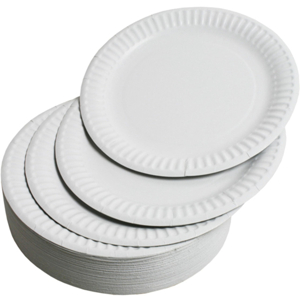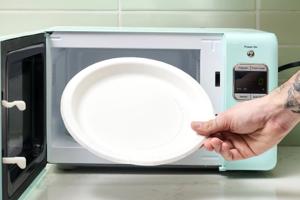
Content Menu
● Understanding Disposable Plates
>> 1. Paper Plates
>> 2. Plastic Plates
>> 3. Foam Plates
● Best Practices for Microwaving Disposable Plates
● Alternatives to Disposable Plates
>> Benefits of Reusable Dishes
● The Environmental Impact of Disposable Plates
>> 1. Waste Generation
>> 2. Resource Consumption
>> 3. Recycling Challenges
● Making Informed Choices
● Conclusion
● Frequently Asked Questions
>> 1. Can I use any paper plate in the microwave?
>> 2. What happens if I microwave a non-microwave-safe plate?
>> 3. Are all plastic plates safe for microwaving?
>> 4. Is it safe to reheat greasy foods on paper plates?
>> 5. What are better alternatives to disposable plates?
>> 6. How can I tell if a plate is microwave-safe?
>> 7. Can I reuse disposable plates after microwaving?
>> 8. What's the best way to dispose of used disposable plates?
>> 9. Are there eco-friendly alternatives to traditional disposable plates?
>> 10. Can I use aluminum foil in the microwave instead of a plate?
● Citations:
Disposable plates have become a staple in many households and events due to their convenience. However, when it comes to reheating food in the microwave, many people wonder: Are disposable plates microwavable? This article will explore the different types of disposable plates, their safety in microwaves, and best practices for using them.
Understanding Disposable Plates
Disposable plates come in various materials, including paper, plastic, and foam. Each type has its own characteristics that determine whether it is safe to use in a microwave.
1. Paper Plates
Paper plates are widely used for casual dining and parties. They are generally lightweight and convenient but vary in their ability to withstand microwave heat.
- Microwave-Safe Paper Plates: According to the USDA, most paper plates can be microwaved as long as they do not have a glossy finish or plastic coating. These coatings can melt or release harmful chemicals when heated.
- Non-Microwave-Safe Paper Plates: Plates with decorative finishes or coatings should not be microwaved, as they may contain materials that can leach into food when heated.
Advantages of Paper Plates
Paper plates are biodegradable and often made from recycled materials, making them an environmentally friendly option compared to plastic. They are also lightweight and easy to dispose of after use, which is ideal for gatherings.
Disadvantages of Paper Plates
On the downside, paper plates can become soggy if they hold moist foods for too long. Additionally, they may not be sturdy enough for heavier meals, leading to spills and messes.
*Image Caption: Various types of paper plates available for use.*
2. Plastic Plates
Plastic disposable plates are another common option. However, not all plastics are created equal.
- Microwave-Safe Plastics: Look for plates made from polypropylene or polyethylene, which are generally safe for microwave use. Always check for a microwave-safe label.
- Non-Microwave-Safe Plastics: Many plastic plates can warp or melt when exposed to high heat, leading to potential chemical leaching into food.
Advantages of Plastic Plates
Plastic plates are often more durable than paper plates and can hold heavier foods without bending or breaking. They are also available in a wide range of colors and designs, making them suitable for various occasions.
Disadvantages of Plastic Plates
The main concern with plastic plates is the potential health risks associated with certain types of plastic when heated. Some plastics can release harmful chemicals like BPA (Bisphenol A) into food when microwaved.
*Image Caption: Different styles of plastic disposable plates.*
3. Foam Plates
Foam plates (often made from polystyrene) are popular for their sturdiness but are typically not recommended for microwave use.
- Safety Concerns: Heating foam plates in the microwave can cause them to break down and release harmful chemicals into food. Therefore, it's best to avoid using foam plates in the microwave altogether.
Advantages of Foam Plates
Foam plates are lightweight and provide excellent insulation, keeping hot foods warm longer than other materials. They are also relatively inexpensive and widely available.
Disadvantages of Foam Plates
The primary drawback is their unsuitability for microwaving. Additionally, foam is not biodegradable and poses environmental concerns due to its contribution to plastic waste.
*Image Caption: Foam disposable plates commonly used at events.*

Best Practices for Microwaving Disposable Plates
When using disposable plates in the microwave, follow these guidelines to ensure safety:
1. Check Labels: Always look for a microwave-safe label on the packaging before using any disposable plate in the microwave.
2. Avoid High Temperatures: Even if a plate is labeled as microwave-safe, avoid heating food for extended periods or at high temperatures.
3. Limit Greasy Foods: Greasy or oily foods can cause paper plates to weaken and potentially leak or catch fire.
4. Use Plain Plates: Opt for plain white paper plates without any printed designs or coatings that may not be safe.
5. Monitor Heating Time: Keep an eye on your food while it's heating to prevent overheating and ensure that the plate does not begin to warp or melt.
Alternatives to Disposable Plates
If you frequently use microwaves for reheating meals, consider investing in reusable dishes made from glass or ceramic. These materials are generally safer and more durable than disposable options.
Benefits of Reusable Dishes
- Durability: Reusable dishes can withstand higher temperatures without warping or melting.
- Environmental Impact: Using reusable dishes reduces waste generated from disposable products.
- Safety: Glass and ceramic do not leach chemicals into food when heated.
- Versatility: Reusable dishes come in various sizes and styles suitable for different types of meals.
*Image Caption: Durable glass and ceramic dishes suitable for microwaving.*

The Environmental Impact of Disposable Plates
While disposable plates offer convenience, their environmental impact cannot be overlooked. The production and disposal of these products contribute significantly to landfill waste and pollution.
1. Waste Generation
Disposable plates contribute to the growing problem of plastic pollution. Many disposable products end up in landfills where they take years to decompose. Even biodegradable options may take a long time to break down under certain conditions.
2. Resource Consumption
The manufacturing process for disposable plates requires natural resources such as trees (for paper) and petroleum (for plastic). This consumption contributes to deforestation and depletion of fossil fuels.
3. Recycling Challenges
Many disposable products are not recyclable due to contamination from food residues or because they are made from mixed materials that cannot be processed together effectively.
Making Informed Choices
When choosing between disposable and reusable options, consider factors such as convenience, environmental impact, safety, and cost-effectiveness:
- If hosting an event where cleanup needs to be quick and easy, disposable options may be warranted.
- For everyday meals at home, investing in reusable dishes can lead to long-term savings and reduced environmental impact.
- If you must use disposable options occasionally, opt for those labeled as compostable or biodegradable whenever possible.
Conclusion
In summary, while many disposable plates can be microwaved safely, it is crucial to check labels and avoid certain types like foam or those with coatings. For regular microwave users, transitioning to reusable dishes may provide a safer and more environmentally friendly option. By being mindful of what materials you choose for your meals—whether at home or during gatherings—you can contribute positively towards reducing waste while ensuring your food is heated safely.
Frequently Asked Questions
1. Can I use any paper plate in the microwave?
- No, only those labeled as microwave-safe should be used.
2. What happens if I microwave a non-microwave-safe plate?
- It may warp, melt, or release harmful chemicals into your food.
3. Are all plastic plates safe for microwaving?
- No, only those made from specific plastics like polypropylene or polyethylene are safe.
4. Is it safe to reheat greasy foods on paper plates?
- It's best to avoid greasy foods on paper plates as they can weaken and leak.
5. What are better alternatives to disposable plates?
- Consider using glass or ceramic dishes that are safe for microwaving.
6. How can I tell if a plate is microwave-safe?
- Look for a label indicating it is microwave-safe; if unsure, check the manufacturer's guidelines online.
7. Can I reuse disposable plates after microwaving?
- It depends on the type; some may become weakened after heating and should not be reused.
8. What's the best way to dispose of used disposable plates?
- Check local recycling guidelines; compostable options should go into compost bins if available.
9. Are there eco-friendly alternatives to traditional disposable plates?
- Yes! Look for biodegradable options made from materials like bamboo or palm leaves.
10. Can I use aluminum foil in the microwave instead of a plate?
- Aluminum foil should generally be avoided unless specified by the manufacturer; it can cause sparks in the microwave.
Citations:
[1] https://www.tasteofhome.com/article/microwave-paper-plates/
[2] https://m7packaging.co.uk/fr/products/9-inch-round-disposable-plates-50-pack-bagasse-sugarcane-biodegradable-eco-friendly-microwave-safe
[3] https://web.xidian.edu.cn/ysxu/files/6253ce1964ebd.pdf
[4] https://www.reddit.com/r/chemistry/comments/xz8gr5/are_there_any_disposable_plates_that_hold_moist/
[5] https://www.ebay.co.uk/itm/175333462050
[6] https://www.hotpackwebstore.com/collections/microwavable-plate
[7] https://www.anchenggy.com/blog/microwaving-disposable-plates.html
[8] https://www.walmart.com/c/kp/microwavable-paper-plates

















